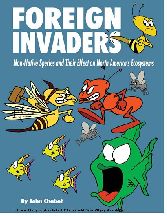Suchen und Finden
3 DUTCH ELM DISEASE (p. 7-8)
In 1921 a Dutch scientist identified a disease that was killing thousands of elm trees in Europe. The name Dutch elm disease refers to the fact that it was in the Netherlands that the discovery was made and not because the disease comes from there. In fact, Dutch elm disease is native to Asia. Dutch elm disease was introduced into America through trade in lumber. Dutch elm disease affects elm trees and it is spread by the elm bark beetle.
The elm bark beetle carries a fungus on its body. The trees are killed by the fungus not by the beetles. The disease was first reported in North America in 1928, with a second more powerful strain arriving in 1940. When an elm tree detects the presence of the fungus inside itself, the tree reacts by clogging some of its tissues with gum. When the tree feeds these clogs prevent nutrients from flowing up the trunk to the diseased part of the tree. Whether it is in a year or five years, that part of the tree will die. Often times the disease will spread to other parts of the tree and eventually the whole tree will die. Once, forests of elm stood tall. Once, elms were the most popular tree used to line urban streets. Now these trees have mostly disappeared from both city and forest. Dutch elm disease has killed over 100 million elm trees.
4 GARLIC MUSTARD
The crushed leaves and stems of this plant taste like garlic and mustard. The plant is called garlic mustard and it is from the mustard family. Garlic mustard was brought to North America from Europe in the mid 1800s. People ate garlic mustard in salads and in recipes and back then it was thought to have some medicinal value. Today, garlic mustard is listed as a noxious weed in several U.S. states. Garlic mustard is a biennial plant, which means it will live for two years. Garlic mustard does not have a flower its first year of growth. The second year it flowers. The second year it spreads its seeds.
Then it dies. Each plant gives off hundreds of seeds, which can be spread long distances by people and animals. Seeds can survive and germinate up to five years after having been produced by the plant. Garlic mustard grows mostly in forests. The problem with garlic mustard is that it spreads rapidly and it takes over from native plant species. Several species of native plants are being eradicated by garlic mustard infestations. On the forest floor a large colony of garlic mustard can prevent sunlight from reaching the ground. Without that sunlight, trees, shrubs and other plants that grow beneath the larger forest trees may not be able to survive. Garlic mustard upsets the balance of plant life in the forest. North American forest ecosystems are threatened by the invasive plant known as garlic mustard.
Alle Preise verstehen sich inklusive der gesetzlichen MwSt.








